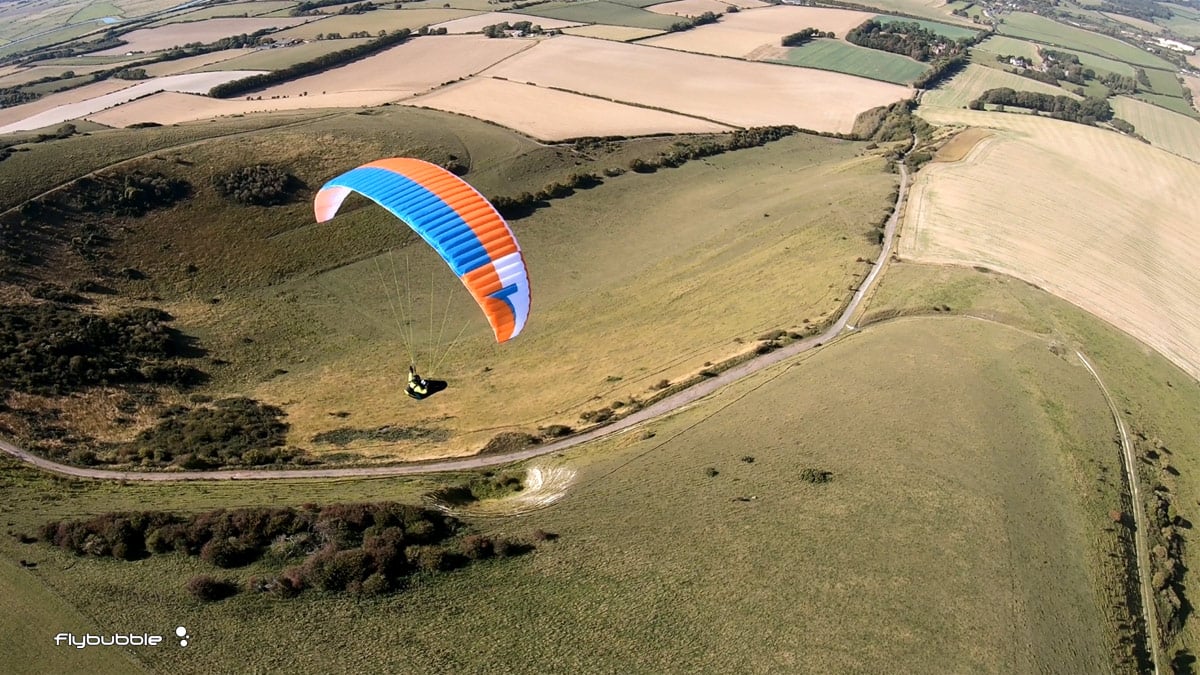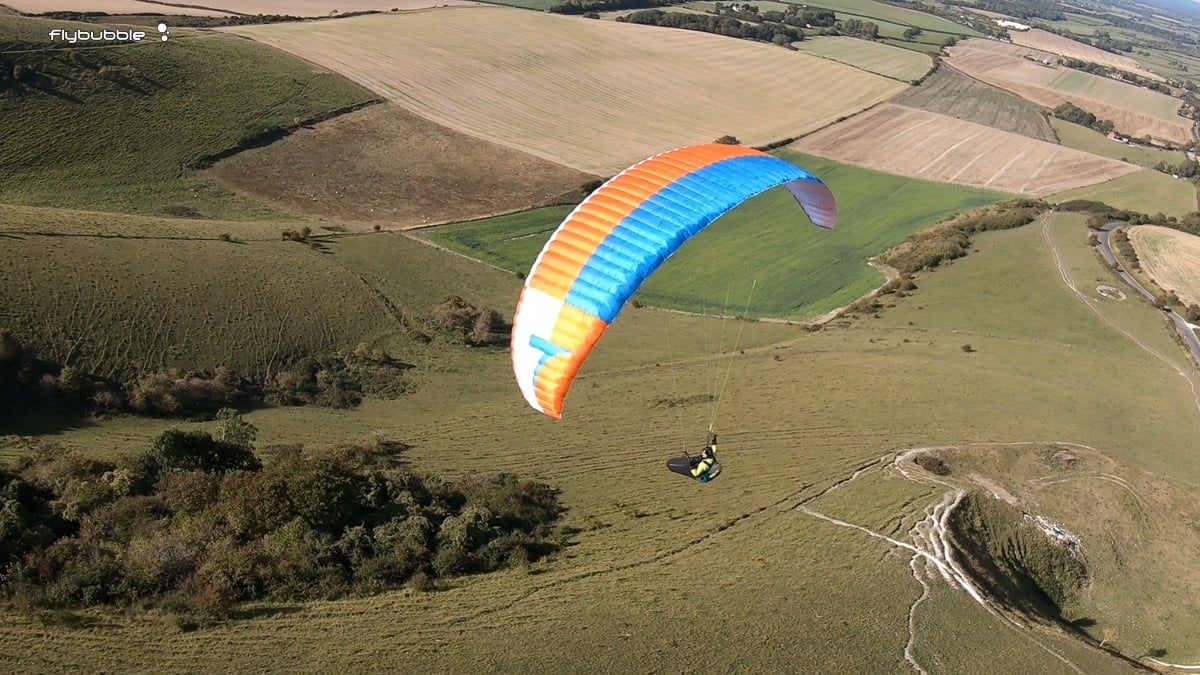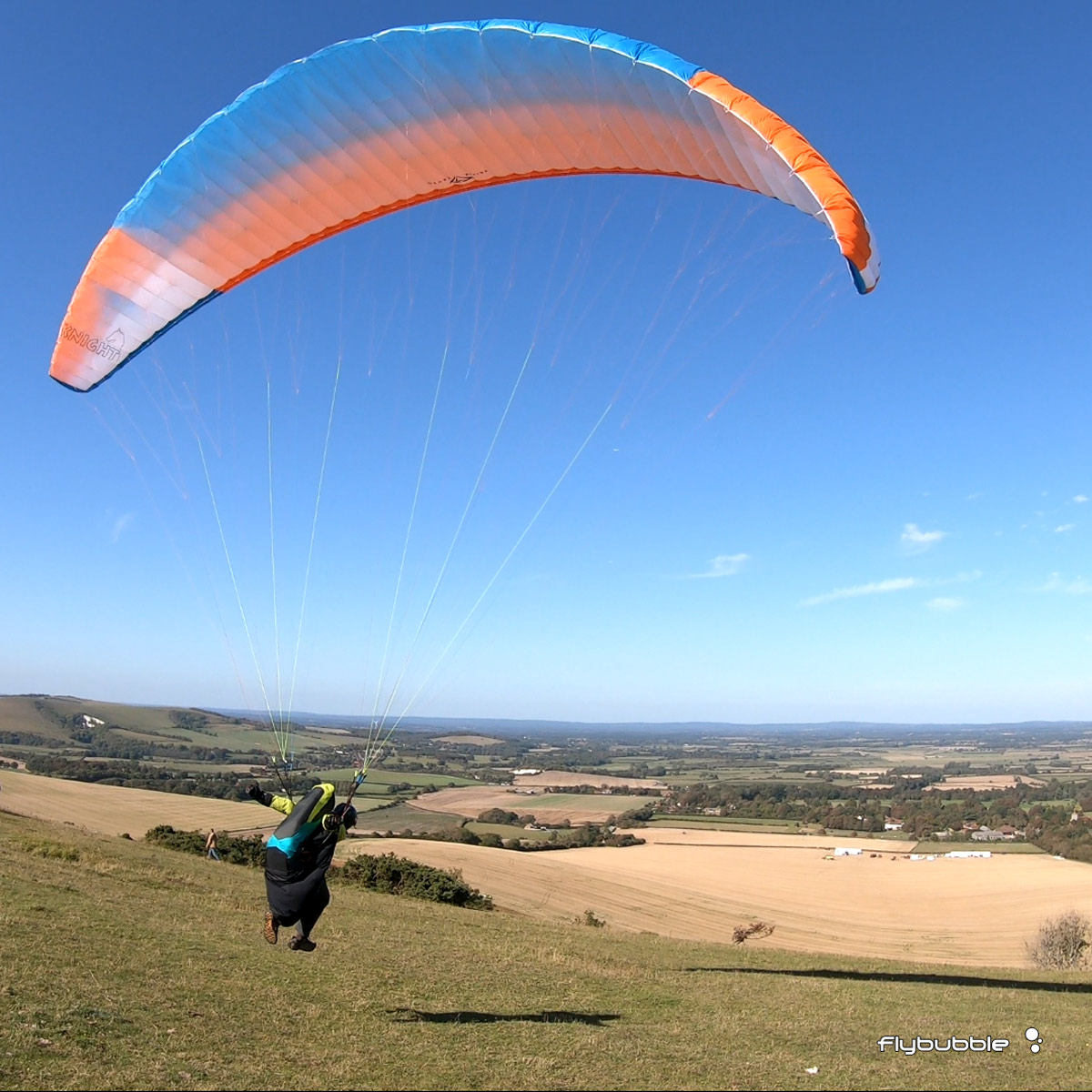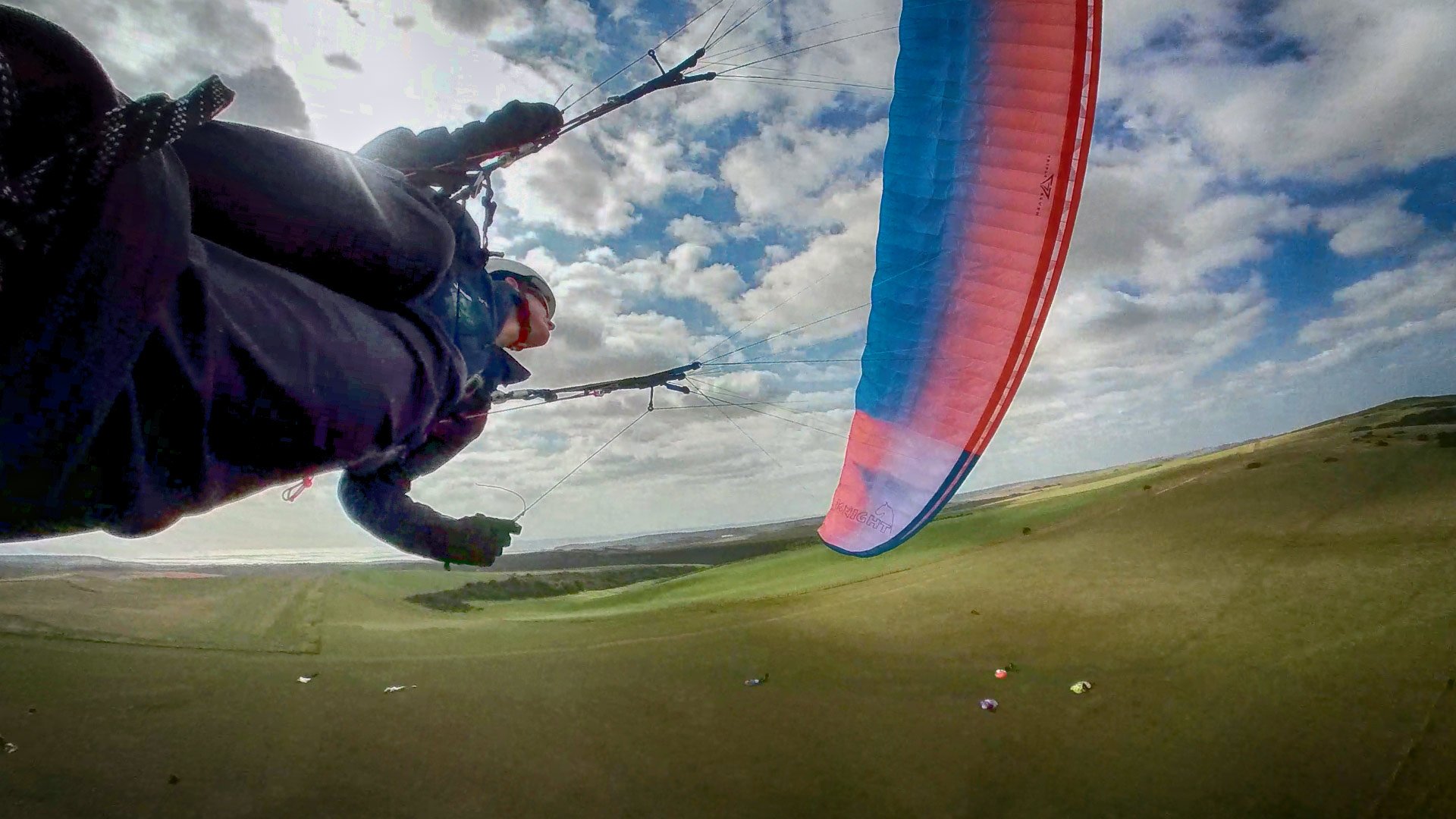
The Triple Seven Knight is made “to make the entry into the world of thermal- and XC flying as easy, intuitive and safe as possible”. A noble goal that matches the aspirations of the largest group of paraglider pilots: the ‘weekend warriors’. Low airtime pilots need a wing that will help them with their progression, and that’s where the Knight fits into the Triple Seven range, between the ‘high A’ Pawn and the ‘high B’ Rook 2. Does it offer the right balance of passive safety and agility for the average EN-B pilot?
Triple Seven Knight: construction

The risers are made to a professional standard, with slim webbing, colour coding, plastic inserts in the maillons, and good magnetic keepers. The lines use an intelligent mix of materials: the main lower lines are sheathed but the upper and rear lines are unsheathed aramid. Although you might prefer some protection on these for harsh launch sites, it does ensure you don’t have a problem with shrinkage that can affect the trim.
The wing is made from durable fabric and has a large pack volume. This might be partly due to the unique reinforcing system. Consisting of a thin Nylon rod sewn into each cell wall in a carefully designed wave pattern, the Load Distribution Technology distributes the loads from each line level across the whole chord of the wing, retaining the correct wing shape regardless of what the air is doing around it. “This translates into a higher resistance to collapses, better energy retention and not least significantly improved gliding performance through turbulent air,” says Triple Seven.
The wing seems large for the weight range: 26.4 m2 flat area for the size I flew (75-95kg), where I am used to seeing about 25 for that level of wing. Although it's not necessary, I recommend flying near the top of the weight range.
Matjaz Klemencic from Triple Seven commented: “The thing about being large for the weight range comes from the fact that the design of the Knight is made, like the Queen 2, with a bit lower profile overall, creating space for larger surface, yet having a better penetration when you are entering the thermal or just cruising in the broken ridge lift. So it is not only the numbers of the surface area ... there is lot more behind it all.”
Triple Seven Knight: on the ground

I found it simple to pin down using the brakes and rear risers together. It rises in a smooth and steady arc, but does require you to retain a little contact with the wing when overhead (it has life). In the lower part of the arc, it tends to settle. The short brake setting means you might inadvertently pull on the brakes during ground-handling when the wing is low, which can complicate kiting back up a slope. It’s best to pull it up through the arc and keep the wing in its happy place, overhead.
Triple Seven Knight: in the air

It feels steady and calm in the air, but it also has a high fun factor, meaning it is responsive and nimble. The brakes engage at a high position and produce a tight turn with a great balance: it does not drop the inside wingtip much, but it doesn’t feel restrained or seem to flatten out, so it is very efficient at thermaling. It is well balanced on the roll axis, and does not require management to keep it level.
It does not feel stiff and will let you know about turbulence. During my testing the tips tucked in during sloppy flying in gusty conditions, so it’s better with some gentle active flying inputs which are very effective at building pressure in the leading edge. Easy to manage, but it requires a ‘real pilot’ and not a ‘sack of potatoes’.
Safety

The ‘rough-guide’ 50% asymmetrics I induced produced a 45 degree direction change and no significant energy. I needed to pump out some of the collapse but this was simple to do whilst maintaining direction. The wing is tolerant of being messed around with.
It has some pitch damping that helps to reduce dives in turbulent air, but it has some freedom of movement that demands basic active flying inputs and gives the wing the good feeling and life in the air. Low spin tendency: pushing too much brake in a turn resulted in a slowly tightening turn. Good stall resistance with obvious increase of brake pressure.
Big ears were easy to induce, and very balanced, with no flapping. They required a single deep pump to clear.
It is comfortable to fly fully accelerated, although I found the optimum feeling at around half bar. All round it is an undemanding wing with high passive safety.
Performance

Handling and safety are more important characteristics in this class, but you get more than enough performance with this wing. It is quick, it has good glide and it climbs very well due to the tight responsive turn. Amongst the usual mix of club pilots, I felt entirely competitive.
Low B or mid B?

Some reviewers class it as a low B (Cross Country magazine, Ziad Bassil). But I agree with Daniel Crespo of ojovolador when he says “when we ask for action, it surprises with its audacity and an intense sporty character” which lifts it to around middle of the EN B category, for me.
It sits above the ‘low B’ wings like the Nova Ion 5 and Skywalk Tequila 5. I think it matches more ‘mid B’ wings like the Phi Tenor and Advance Epsilon 9 and Skywalk Arak. It is less demanding than ‘high B’ wings like the Niviuk Ikuma, Advance Iota 2 and Gin Explorer. Either way, it’s easy to fly and has high passive safety, but it is not entirely accessible as an ‘out of school’ wing, where the Pawn is a better match.
Mark Galetti asked (on Youtube): If you’ve never flown before, why not start with this wing?
Greg Hamerton: Because when you are a beginner your reaction speed is very slow because you don't know know what to do, then the wing can get out of control. A simpler wing gives you more time to react.
Flaj: You should probably start flying first and ask your instructor what glider is best for you. Some people need lower aspect ratio and for some lower will slower the progress. My first wing was good old Dudek Optic which was 5.45 (Knight is 5.4) and it was just perfect. It's individual thing, for me it was easier cause of 6 years experience with gliders/sailplanes but I have friends without any experience in flying and their input was not enough for this wing. I have also friends that will fly their EN-A for long long time. Go to your local school and let the instructor watch your progress.
Carlo Borsattino: From my experience of flying, instructing, coaching and advising pilots for over 27 years there's no one right answer for every pilot about equipment... or pretty much anything in flying, actually! The right choice is always a very individual thing. From what I've seen, the biggest mistake pilots can make with equipment, especially wings and harnesses, is buying something that's too hot for them. This mostly turns out to be a costly mistake that holds back their flying, rather than accelerates their learning. For some it may even end their flying completely, either because they get scared and lose the joy of flying, or have an accident.
The best high EN A and low B wings have such good performance and handling nowadays that they offer everything almost every new pilot needs. Only a small percentage of exceptionally talented and highly ambitious new pilots actually benefit from getting anything more than this as their first wing. Even then, these pilots usually push their luck too hard and would benefit from the extra passive safety of a high A or low B wing.
Most pilots get the most out buying of a modern 'high A' wing as their first wing. In Triple Seven's range, that's the Pawn. Some pilots would actually get the most from a low A wing, for example the Triple Seven Deck
To help pilots get some idea of the level of different first first buy paragliders, we've divided these into 'high safety', 'best of both' and 'ambitious'. The Triple Seven Knight is in the 'ambitious' category.
Triple Seven Knight: Who is it for?

The Knight is a fun and agile intermediate wing that is best suited to pilots with good feeling and awareness. It is an ideal match with pilots in their second year of flying, where enthusiasm can sometimes outstrip ability, and having a wing that can take the punches and put you down safely when you have made a mistake is a great benefit. The performance makes cross country flying easily achievable. The precise construction and durable material choices create a dependable wing that will be your trusted companion for many years and should retain its value as the reputation of Triple Seven continues to grow.
Find out more about the Triple Seven Knight
Review video
Join Greg as he tests the capabilities of the Triple Seven Knight on an aerial chessboard. Two forward, one to the left…
Brought to you by Flybubble
Like what we do? The best way to thank and support us is to buy gear from us and recommend us to others. Review our service on Trustpilot and our products on Flybubble Shop. You can also subscribe to Flybubble Patreon. Thank you!

